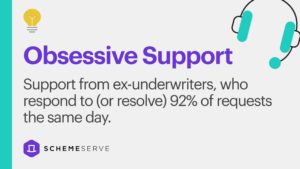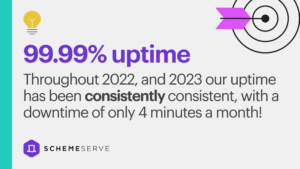In today’s fast-paced insurance industry, reliable software is crucial for streamlined operations and exceptional customer service. However, not all insurance software systems are created equal. This article highlights common red flags to watch for in insurance software and explores their potential consequences.
#1: Poor support
The quality of support provided by the software vendor or support team is a critical factor for insurance professionals. When shopping for insurance software, it’s important to consider the level of support you can expect. Slow or unresponsive support, lack of knowledgeable staff, and ineffective issue resolution can have a detrimental impact on your operations.
As an insurance professional, you rely on prompt assistance and guidance to address any issues or concerns that may arise. A high-quality support system with a responsive and knowledgeable support team is essential for ensuring smooth software operation and user satisfaction. Timely issue resolution and proactive communication are key to a positive user experience. By choosing a software provider with a strong support system, you can minimise downtime, resolve issues efficiently, and maximise the benefits of the software for your insurance business.
#2: Hard to use
The ease of use of insurance software is a crucial consideration when shopping for insurance solutions. As an insurance professional, you want software that enhances your productivity and efficiency. Complex interfaces, unintuitive workflows, and unclear instructions can impede your experience and lead to errors and inefficiencies.
Look for software that prioritises intuitive design, user-friendly interfaces, and minimal learning curves. An easy-to-navigate interface, logical workflows, and comprehensive training resources are essential for enabling you to quickly understand and perform tasks without unnecessary complexity. Features like contextual help, tooltips, and clear documentation further enhance the ease of use.
By choosing user-friendly software, you can enhance your satisfaction, minimise errors, and improve overall operational efficiency in your insurance operations.


#3: Security vulnerabilities
It’s crucial to prioritise security measures to protect sensitive customer data. Security vulnerabilities in software systems can lead to serious consequences, including data breaches, financial losses, reputation damage, and legal repercussions.
As an insurance professional, you must ensure that the software you choose prioritises security. Look for software providers who have a history of robust security measures, including strong encryption, robust authentication mechanisms, and regular security updates.
By addressing security vulnerabilities, insurance software can create a secure environment that instills customer confidence and ensures the integrity of confidential information. Protecting customer data and maintaining compliance with industry regulations should be top priorities when evaluating insurance software options.
#4: Uptime issues
Consider the uptime performance of the platform. Uptime refers to the percentage of time the software is available and operational. Frequent system downtime, lack of proactive monitoring, and insufficient backup and recovery mechanisms can disrupt your business operations, increase costs, decrease productivity, and potentially lead to the loss of critical data or transactions.
As an insurance professional, you rely on software for your day-to-day operations, and any interruption can have severe consequences. High uptime is a strong indication of the software’s stability, reliability, and the vendor’s commitment to providing a seamless user experience.
Look for insurance software providers that have robust infrastructure, redundancy measures, proactive monitoring, and reliable backup and recovery mechanisms. By choosing software with high uptime, you can ensure uninterrupted access, smooth operation, and have peace of mind knowing that your critical operations will not be hindered.
#5: Poor customer reviews
Customer reviews provide valuable insights into user experiences. Poor customer reviews can serve as a red flag, indicating dissatisfaction among users. These reviews often shed light on recurring issues such as software bugs, data quality problems, integration challenges, security vulnerabilities, or inadequate customer support.
The consequences of poor customer reviews can have a significant impact, including decreased user confidence, lower adoption rates, potential loss of business, damaged reputation, and difficulties in recruiting new customers. It is crucial to address these concerns promptly and effectively to improve the software’s performance, enhance user satisfaction, and restore confidence in the product.
By actively listening to customer feedback and taking appropriate measures, insurance software providers can make necessary improvements, deliver a better user experience, and ensure customer satisfaction.
#6: Software bugs
When searching for insurance software, it’s crucial to be aware of the potential presence of software bugs. These bugs can result in system crashes, inconsistent calculations, unexpected behavior, missing or corrupted data, and error messages. The existence of software bugs can lead to malfunctioning software, inaccurate outcomes, errors in policy management, and compromised data integrity.
Insurance professionals depend on software to handle critical operations, making software bugs a significant concern that can greatly impact productivity, accuracy, and customer satisfaction. It is vital to promptly identify and address bugs to ensure stable and reliable software performance, providing insurance professionals with the efficiency and accuracy they require in their daily operations.
By choosing insurance software that prioritises bug identification and resolution, you can minimise disruptions, improve accuracy, and enhance overall user satisfaction.
#7: Integration problems
Efficient integration is essential for seamless communication between insurance software and other systems or third-party applications. Integration problems, such as incompatible data formats, communication failures, incorrect data mapping, or limited third-party integration support, can impede the exchange of data, create operational disruptions, and cause delays in information sharing. These issues can result in data discrepancies, inefficiencies, and decreased productivity.
Insurance professionals rely on smooth integration capabilities to streamline their processes and ensure accurate data flow across systems. Choosing insurance software with robust integration features can help minimise integration challenges, facilitate efficient data exchange, and enhance overall operational efficiency.
By selecting a software solution with strong integration capabilities, you can ensure seamless communication between your insurance software and other critical systems, enabling you to optimise your workflows and achieve higher levels of efficiency.


SchemeServe: A reliable insurance software solution
At SchemeServe, we understand the importance of reliable and efficient insurance software. We address common red flags found in insurance software, such as software bugs, data quality issues, integration problems, and security vulnerabilities, which can hinder productivity, accuracy, and customer satisfaction.
With SchemeServe, you can experience a software solution that excels in addressing these concerns. Our rigorous testing processes ensure stable and reliable software performance, minimising the risk of bugs and compromised data integrity. We prioritise data integrity through robust validation and integration capabilities, enabling accurate calculations and informed decision-making.
At SchemeServe, we pride ourselves on exceptional Obsessive Support, maintaining a 92% same-day response rate. Our user-friendly interface and comprehensive training resources enhance ease of use, reducing errors and improving efficiency.
Moreover, our impressive 99.99% uptime guarantees a stable and uninterrupted software experience, maximising your productivity and minimising downtime-related costs.
Choose the right software for success in the dynamic insurance industry. Experience the benefits of SchemeServe and join insurance professionals who have streamlined operations, delivered exceptional customer service, and achieved operational excellence. Contact us now to explore how SchemeServe can transform your insurance operations.


